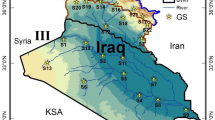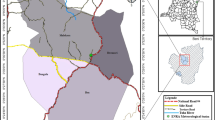Abstract
This research has presented a drought index, the harmonic mean of vertical and horizontal standardized precipitation indices obtained from two different cumulative rainfall distributions. The recent estimations of droughts in northwestern Bangladesh are highly inconsistent and not adequately aligned with the agricultural productions. This study has identified the reasons behind these inconsistencies. Firstly, the previous studies did not consider the effects of very low seasonal rainfall distributions, and secondly, they made improper uses of time scales in the computations of standardized precipitation index. The proposed drought index has overcome the limitations of the earlier standardized precipitation index and properly addressed the reasons, and estimated the meteorological droughts in the study area. Results show that various areas in northwestern Bangladesh were under moderate droughts in 1992, 1994, 2010, 2012, and 2016, and Dinajpur was close to severe drought in 1994. These droughts are not found to significantly impact agricultural production in the region and have not left any reasonable signatures on production losses. The findings obtained are well supportive of the agricultural production statistics. The drought index presented in this study is a more accurate way of determining droughts in regions with low seasonal rainfall and identifying problems with smooth agricultural production. Moreover, the high-frequency mild meteorological droughts have been estimated as a common feature of the study period though these mild droughts may turn to severe or extreme droughts.










source:
Similar content being viewed by others
References
Ahmed B, Kelman I, Kamruzzaman M, Mohiuddin H, Rahman MM, Das A, Fordham M, Shamsudduha M (2019) Indigenous people’s responses to drought in northwest Bangladesh. Environmental Development 19:55–66. https://doi.org/10.1016/j.envdev.2018.11.004
Bandyopadhyay N, Saha AK (2016) A comparative analysis of four drought indices using geospatial data in Gujarat, India. Arab J Geosci 9:341. https://doi.org/10.1007/s12517-016-2378-x
Bangladesh Agricultural Research Council (2001) Application of agroecological zones database in drought management and water availability assessment, Environment and GIS Support Project for Water Sector Planning, Ministry of Water Resources, Government of Bangladesh, Dhaka.
Bangladesh Bureau of Statistics and Statistics and Informatics Division (2018) 45 years agriculture statistics of major crops (aus, amon, boro, jute, potato & wheat), Ministry of Planning, Government of Bangladesh, Dhaka.
Bangladesh Meteorological Department (2021) Normal monthly rainfall: average normal rainfall in mm, meteorological complex, Agargaon, Dhaka-1207, Bangladesh, 1p. http://live.bmd.gov.bd/p/Normal-Monthly-Rainfall/ retrieved on September 26, 2021.
Banglapedia (2021) Agricultural calendar, the National Encyclopedia of Bangladesh. https://en.banglapedia.org/index.php/Agricultural_Calendar retrieved on 14 July 2021.
Bazza M, Kay M, Knutson C (2018) Drought characteristics and management in North Africa and the Near East, Food and Agriculture Organization Of The United Nations, FAO WATER REPORTS 45, Rome, 250p.
Brammer H (1987) Drought in Bangladesh: lessons for planners and administrators. Disasters 11(1):21–29
Byun HR, Wilhite DA (1999) Objective quantification of drought severity and duration, Drought Mitigation Center Faculty Publications 32. http://digitalcommons.unl.edu/droughtfacpub/32.
Center for Environmental and Geographic Information Services (2013) Vulnerability to climate induced drought scenario & impacts, Study Report. Comprehensive Disaster Management Program, Dhaka 1212, Bangladesh.
Choudhury AM, Quadir DA, Neelormi S, and Ahmed AU (2003) Climate change and its impacts on water resources of Bangladesh, In: A. Muhammed (ed.), Climate Change and water Resources in South Asia, Asianics AgroDev International, 2003, Islamabad, 21–60.
Edwards DC, McKee TB (1997) Characteristics of 20th century drought in the United States at multiple time scales, Climatology Rep. 97–2, Department of Atmospheric Science, Colorado State University, Fort Collins, CO, 155p.
Ferger WF (1931) The nature and use of the harmonic mean. J Am Stat Assoc 26(173):36–40
Habiba U, Hassan AWR, Shaw R (2013) Livelihood adaptation in the drought prone areas of Bangladesh. Climate Change Adaptation Actions in Bangladesh, Springer, Tokyo 30:227–252. https://doi.org/10.1007/978-4-431-54249-0
Habiba U, Shaw R, Takeuchi Y (2011) Drought risk reduction through a socio-economic, institutional and physical approach in the northwestern region of Bangladesh. Environ Hazards 10(2):121–138. https://doi.org/10.1080/17477891.2011.582311
Hayes MJ, Svoboda MD, Wiihite DA, Vanyarkho OV (1999) Monitoring the 1996 drought using the standardized precipitation index. Bull Am Meteor Soc 80(3):429–438
Islam ARMT, Shen S, Hu Z, Rahman MA (2017) Drought hazard evaluation in Boro paddy cultivated areas of western Bangladesh at current and future climate change conditions, Advances in Meteorology 2017: ID 3514381, 12p. DOI: https://doi.org/10.1155/2017/3514381
Jerin JN, Islam ARMT, Mamun MAA, Mozahid MN (2021) Ibrahim SM (2021) Climate change effects on potential evapotranspiration in Bangladesh. Arab J Geosci 14:682. https://doi.org/10.1007/s12517-021-07010-9
Karavitis CA, Alexandris S, Tsesmelis DE, Athanasopoulos G (2011) Application of the standardized precipitation index (SPI) in Greece. Water 3(3):787–805. https://doi.org/10.3390/w3030787
Karim Z, Iqbal MA (eds) (2001) Impact of land degradation in Bangladesh: changing scenario in agricultural land use. Bangladesh Agricultural Research Council, Dhaka
Karim Z, Ibrahim AM, Iqbal A, Ahmed M (1990) Drought in Bangladesh agriculture and irrigation schedules for major crop, Bangladesh Agricultural Research Council. Soils Publication 34:11
Kumar MN, Murthy CS, Saib MVRS, Royb PS (2009) On the use of standardized precipitation index (SPI) for drought intensity assessment. Meteorol Appl 16:381–389. https://doi.org/10.1002/met.136
Lindstrom PA (1988) The average of rates and the average rate. HiMAP Pull-out Section: Spring 1988:7p
Liu Q, Zhang S, Zhang H, Bai Y, Zhang J (2020) Monitoring drought using composite drought indices based on remote sensing. Sci Tot Environ 711:134585. https://doi.org/10.1016/j.scitotenv.2019.134585
Malik A, Kumar A (2021) Application of standardized precipitation index for monitoring meteorological drought and wet conditions in Garhwal region (Uttarakhand). Arab J Geosci 14:800. https://doi.org/10.1007/s12517-021-07158-4
Mamun MAA, Rahman SM, Uddin MN, Islam MS, Arifin MNK, Rahman SM (2021) Rainfall and drought tendencies in Rajshahi division, Bangladesh, Geography. J. Environ. Sustain 14(1):209–218. https://doi.org/10.24057/2071-9388-2020-124
Mckee (1993) Regional W, Drought N, States U. Methodology 3.1 SPI Defined McKee.
Miyan MA (2015) Droughts in Asian least developed countries: vulnerability and sustainability. Weather and Climate Extremes 80(3):429–438
Mondal MAH, Ara I (2017) Das SC (2017) Meteorological drought index mapping in Bangladesh using standardized precipitation index during 1981–2010. Advances in Meteorology 4642060:17. https://doi.org/10.1155/2017/4642060
Nury AH, Hasan K (2016) Analysis of drought in Northwestern Bangladesh using standardized precipitation index and its relation to Southern oscillation index. Environmental Engineering Research 21(1):58–68
Omondi PA (2010) Agricultural drought indices in the greater horn of Africa (GHA) countries, In: Sivakumar, MVK, Motha RP, Wilhite D and Wood DA (Eds), Agricultural drought indices, Proceedings of an Expert Meeting, 2–4 June, 2010, Murcia, Spain, 106–112.
Ostroff AC, Muhlfeld CC, Lambert PM, Booth NL, Carter SL, Stoker JM and Focazio MJ (2017), USGS integrated drought science: U.S. Geological Survey Circular 1430, 24p. https://doi.org/10.3133/cir1430 retrieved on 17 July 2021.
Palmer WC (1965) Meteorological drought. U.S. Weather Bureau, Res. Pap. No. 45.
Qaisrani ZN, Nuthammachot N, Techato K, Asadullah, (2021) Drought monitoring based on standardized precipitation index and standardized precipitation evapotranspiration index in the arid zone of Balochistan province, Pakistan. Arab J Geosci 14:11. https://doi.org/10.1007/s12517-020-06302-w
Rahman A, Biswas PR (1995) Devours resources. Dhaka. Courier 11(42):7–8
Rahman AA, Alam M, Alam SS, Uzzaman MR, Rashid M, Rabbani G (2008) Risks, vulnerability and adaptation in Bangladesh, Human Development Report 2007/08, Human Development Report Office Occasional Paper, 2007/13. http://hdr.undp.org/en/content/risks-vulnerability-and-adaptation-bangladesh, retrieved on 13 July 2021.
Rahman MM and Islam MA (Eds.) (2008) Climate change and the vulnerability of Bangladesh, Climate Change Cell, Department of Environment Comprehensive Disaster Management Program, Dhaka, Bangladesh, 16p.
Rahman MR, Lateh H (2016) Meteorological drought in Bangladesh: assessing, analysing and hazard mapping using SPI GIS and Monthly Rainfall Data. Environ. Earth Sci 75(12):1026
Rahman SM, Rahman SM, Ali MS, Mamun MA, Uddin MN (2020) Estimation of seasonal boundaries using temperature data: a case of northwest part of Bangladesh. Mathematics of Climate and Weather Forecasting 6(1):50–62. https://doi.org/10.1515/mcwf-2020-0102
Rakib Z (2018) Characterization of climate change in southwestern Bangladesh: trend analyses of temperature, humidity, heat index, and rainfall. Climate Res 76(3):241–252
Saha TR, Shrestha K, PK, Rakovec O, Thober S, Samaniego L, (2021) A drought monitoring tool for South Asia. Environ Res Lett 16:054014. https://doi.org/10.1088/1748-9326/abf525
Shahid S (2008) Spatial and temporal characteristics of droughts in the western part of Bangladesh. Hydrol Process 22(13):2235–2247. https://doi.org/10.1002/hyp.6820
Shahid S, Chen X, Hazarika MK (2005) Assessment aridity of Bangladesh using geographic information System. GIS Development 9(12):40–43
Uddin MJ, Hu J, Islam ARMT, Eibek KU, Nasrin ZM (2020) A comprehensive statistical assessment of drought indices to monitor drought status in Bangladesh. Arab J Geosci 13:323. https://doi.org/10.1007/s12517-020-05302-0
Vicente-Serrano SM, Beguería S, Lorenzo-Lacruz J et al (2012) Performance of drought indices for ecological, agricultural, and hydrological applications. Earth Interact 16(10):1–27. https://doi.org/10.1175/2012EI000434.1
Wilhite DA, Glantz M (1985) Understanding: the drought phenomenon: the role of definitions. Water International 10(3):111–120. https://doi.org/10.1080/02508068508686328
World Meteorological Organization (WMO) and Global Water Partnership (GWP) (2016) Handbook of Drought Indicators and Indices (M. Svoboda and B.A. Fuchs). Integrated Drought Management Programme (IDMP), Integrated Drought Management Tools and Guidelines Series 2. Geneva.
Acknowledgements
The authors are grateful to the anonymous reviewers and editor for their thoughtful comments and suggestions to improve this research work. The authors thank Professor Abdullah Al Mamun, Department of English, and Mr. Md. Feroz Ibne Rahman, Research Scholar, IBS, University of Rajshahi for their support in editing the final manuscript. The authors also thank Bangladesh Meteorological Department, National Water Resources Database, and Bangladesh Bureau of Statistics for using their data in this study.
Author information
Authors and Affiliations
Corresponding author
Ethics declarations
Conflict of interest
The authors declare no competing interests.
Additional information
Responsible Editor: Zhihua Zhang
Publisher's note
Springer Nature remains neutral with regard to jurisdictional claims in published maps and institutional affiliations.
Rights and permissions
About this article
Cite this article
Rahman, S.M., Faruk, M.O., Rahman, M. et al. Drought index for the region experiencing low seasonal rainfall: an application to northwestern Bangladesh. Arab J Geosci 15, 277 (2022). https://doi.org/10.1007/s12517-022-09524-2
Received:
Accepted:
Published:
DOI: https://doi.org/10.1007/s12517-022-09524-2




